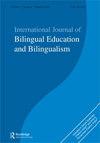翻译:一种异义希望的教育学
IF 2.5
2区 文学
Q1 EDUCATION & EDUCATIONAL RESEARCH
International Journal of Bilingual Education and Bilingualism
Pub Date : 2023-05-13
DOI:10.1080/13670050.2023.2212835
引用次数: 0
摘要
摘要翻译研究记录了多语言、多模式转换和后多语言时代的语言实践。尊重并符合学生跨语言可供性的跨语言实践仍有探索的空间。这些做法如何抵消课堂上的单语言压力及其在师生动态中的表现?对双语/多语言学生的日益关注包括呼吁开发有意义的、异质的学习环境,以维持他们的文化和语言曲目。作为一种希望的教育学,跨语言通过(a)提高学生的认知和语言学习,(b)为所有人创造进入学习社区的入口,以及(c)在多语言课堂上实施更公正、公平和人性化的教学实践,来抵消单语偏见。本期特刊收录了五篇精心策划的文章,这些文章共同展示了跨语言如何为教师和学生、年龄和背景以及通过多种方式转变单语言观点和实践带来希望。这些文章中出现了一些新的、有意义的贡献,为当前的跨语言知识库提供了信息。其中包括对少数民族语言空间内的跨语言实践的洞察,跨语言教学法的不确定性和紧张性,作为教师自我反思和批判性的工具的跨语言,作为跨语言切入点的多模态,以及对跨语言实践的纵向考察。本文章由计算机程序翻译,如有差异,请以英文原文为准。
Translanguaging: a pedagogy of heteroglossic hope
ABSTRACT
Translanguaging research has documented language practices within the multilingual, multimodal turn and the post-multilingualism era. Space still remains for inquiry into translanguaging practices that respect and align with students’ multilingual affordances across languages. How might these practices counteract monoglossic pressures in classrooms and their appearance in/through teacher-student dynamics? Growing attention given to bi/multilingual students includes a call to develop meaningful, heterogeneous contexts of learning that sustain their cultural and linguistic repertoires. As a pedagogy of hope, translanguaging counteracts monoglossic bias by (a) enhancing students’ cognition and language learning, (b) creating entry points for all into learning communities, and (c) enacting more just, equitable, and humanizing instructional practices in multilingual classrooms. This special issue features five carefully curated articles that together showcase how translanguaging offers hope for shifting monoglossic perspectives and practices across teachers and students, ages and contexts, and through multimodal means. Several new and meaningful contributions emerge from these articles to inform the current translanguaging knowledge base. These include insight into translanguaging practice within minoritized languaging spaces, the uncertainties and tensions of translanguaging pedagogy, translanguaging as a vehicle for teacher self-reflection and criticality, multimodality as an entry point into translanguaging, and longitudinal examinations of translanguaging practice.
求助全文
通过发布文献求助,成功后即可免费获取论文全文。
去求助
来源期刊
CiteScore
7.90
自引率
7.10%
发文量
93
期刊介绍:
The aim of this Journal is to be thoroughly international in nature. It disseminates high-quality research, theoretical advances, international developments to foster international understanding, and to spread ideas about initiatives in bilingualism and bilingual education. The Journal seeks: • To promote theoretical and applied research into bilingual education and bilingualism. • To provide a truly international exchange, and to encourage international debates and discussions on key issues in areas of controversy in bilingual education and bilingualism. audience.

 求助内容:
求助内容: 应助结果提醒方式:
应助结果提醒方式:


